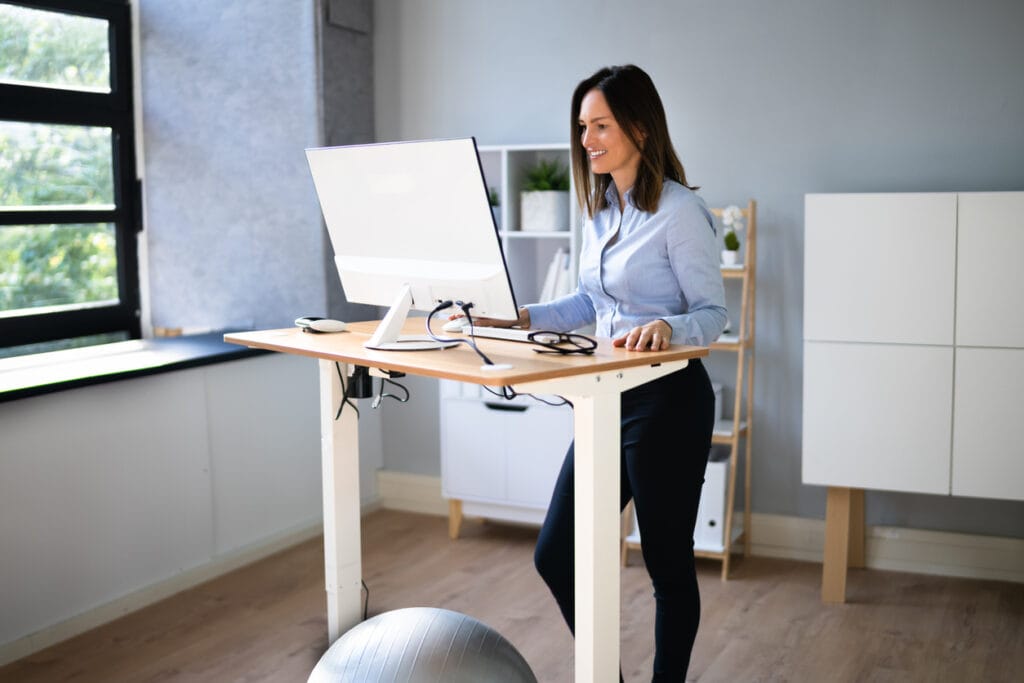We’ve outlined the Pros and Cons of sitting and standing at your desk, first let’s take a look at sitting;
Pros
- Support and Stability – Sitting provides a stable and consistent base of support for tasks that require fine motor skills such as typing, drawing or detailed writing.
- Reduction of fatigue – Prolonged standing can lead to fatigue, particularly in the legs and lower back; sitting in a correctly set up office chair reduces strain on the legs and allows muscles to relax.
- Adjustability – as alluded to above, a suitable office chair will have adjustable height, adjustable lumbar support, adjustable tilt angle and tension allowing for better support and alignment in sitting.
Cons
- Risks of prolonged sitting – Extended periods of sitting are associated with increased risk of musculoskeletal issues, cardiovascular disease, obesity and reduced life expectancy.
- Back discomfort – Prolonged sitting, particularly with incorrect set up of lumbar support, causes pain and discomfort in the low back region
- Circulation issues – Sitting for long periods slows the heart rate and consequently blood circulation, particularly in the legs which can lead to swelling, increased long term risk of DVT and chromic venous insufficiency leading to varicose veins.

Using a standing desk offers several health benefits but there are also cons, particularly for individuals who spend long hours working at a desk. Let’s see;
Pros
- Reduced risk of obesity and heart disease – standing more often during the day can increase energy expenditure and heart rate, which can help in reducing the risk of weight gain and cardiovascular conditions.
- Posture – standing encourages postural correction and increases muscle activity throughout the body and helps to avoid slumping postures that prolonged sitting can encourage
- Increased movement – standing allows ease of movement, weight shifting and stretching which helps reduce stiffness and discomfort associated with prolonged static postures.
Cons
- Leg and foot strain – Prolonged standing can lead to discomfort or pain in the feet, knees and hips particularly on harder surfaces
- Varicose Veins – Continuus standing can increase pressure in the veins of the legs due to blood pooling, potentially leading to varicose veins
- Back pain – While standing promotes better posture, prolonged standing causing fatigue and poor standing habits can contribute to low back pain
- Balancing sitting and standing
Working At Your Desk For Long Periods;
Alternating positions – The best approach to office work is to alternate between sitting and standing throughout the day. Sit-stand desks are designed for this purpose, allowing users to adjust their workspace to either position easily while continuing to work.
Ergonomic setup – Whether in sitting or standing, ergonomic principles should be adhered to in both positions e.g. monitor address bar at eye level to avoid neck strain
Movement is the key – Regardless of the position, moving regularly throughout the day is important. Taking breaks from screens and from the workspace at large can help to reduce the risks associated with sitting or standing.
Practical Application
Sitting
Ensure the chair provides good lumbar support, allowing feet to rest flat on the floor or implement a footrest if required.
Keep joint angles close to 90 degrees as a rule of thumb, this provides optimal support from floor, seat pan, back rest, lumbar support and arm rests if they are available.
Be sure to take regular movement breaks away from the sitting position throughout the day
Standing
Shift weight from one leg to another regularly to alleviate any discomfort of standing
An antifatigue mat or standing on a rug or carpeted floor can increase comfort in standing
Be sure to take regular breaks from standing at the workstation; either sit or take a walk away from the workstation if possible
Conclusion
Balancing sitting and standing is essential for maintaining overall health and well-being in the workplace. Neither position is inherently better than the other without the proper dosage; the key is to switch between both regularly and to ensure that the rest of your workstation is set up with good ergonomic principles throughout. Regular movement, good posture and proper workstation setup can reduce the risks associated with sitting and standing.
If you’d like to find out how Spectrum Health can provide you with a comprehensive Ergonomic solution for your employees, get in touch with us today: Ergonomics By Spectrum Health












